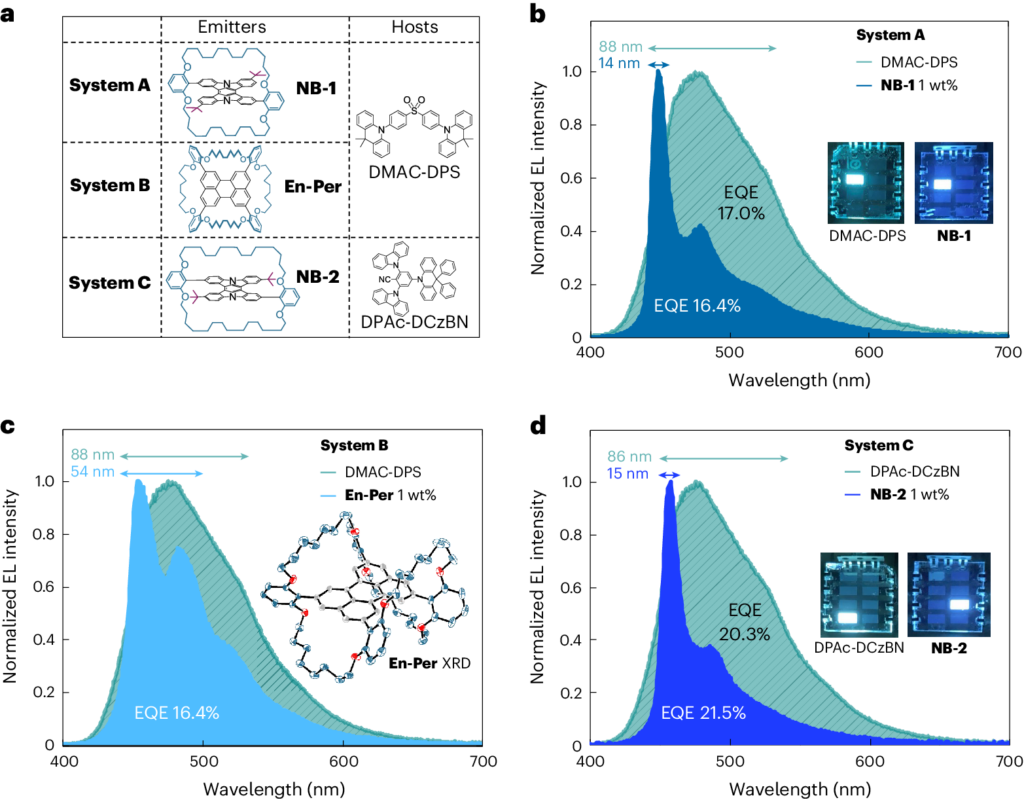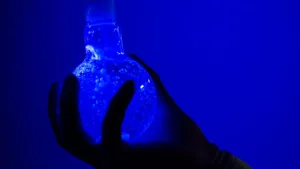Organic light-emitting diodes (OLEDs) are the current gold standard for vibrant, energy-efficient displays. However, making high-performance blue OLEDs, especially narrowband deep blue, has been a persistent challenge. Researchers from the University of Cambridge may have found an elegant solution by developing novel encapsulated emitters.
In current state-of-the-art blue OLEDs, the emissive layer contains three components – a sensitizer molecule, an emitter molecule, and a high energy gap matrix material. The matrix is necessary to prevent energy transfer from the sensitizer to the emitter triplet states, which reduces efficiency and stability. However, this makes blue OLED fabrication complex.
The Cambridge team, led by Hugo Bronstein, designed ultranarrowband blue emitters NB-1 and NB-2 where the emissive core is encapsulated by insulating alkylene straps. When doped into a sensitizer host without any matrix, the straps effectively suppress the undesirable energy transfer while allowing the desired singlet transfer.

Using transient absorption spectroscopy, they directly observed for the first time that detrimental energy transfer from a sensitizer to non-encapsulated emitter triplets does occur and that encapsulation dramatically reduces it. As a result, OLEDs made with just a sensitizer host and 1% of the encapsulated emitters achieved external quantum efficiencies up to 21.5% – on par with the sensitizer-only devices. Simultaneously, the electroluminescence spectra narrowed dramatically from over 80 nm to a record-equaling 14-15 nm.
This research directly addresses the “blue OLED problem” – the long-standing challenge of developing efficient, stable, and narrowband deep blue organic light-emitting diodes (OLEDs).
Specifically, the key problems this work tackles are:
- The need for a high triplet energy matrix material in the emissive layer of current state-of-the-art blue OLEDs. This matrix is essential to prevent efficiency and stability losses caused by Dexter energy transfer from the sensitizer to the emitter triplet states. However, it makes device fabrication complex and reduces power efficiency.
- The lack of an efficient “matrix-free” blue OLED design. Previous attempts at two-component emissive layers without a matrix have suffered from poor efficiency due to the Dexter losses to the emitter triplets.
- The difficulty in achieving deep blue emission with a very narrow spectral width. Narrowband deep blue is desirable for color purity in displays but has been challenging to attain, with the narrowest blue OLEDs having full-width at half-maximum (FWHM) of around 14-15 nm.
Another consideration that is more practical is that current OLED TVs, while having great picture quality, suffer from high costs and relatively short lifespans compared to other screen technologies. The blue subpixels in OLED displays are the least stable and can cause screen ‘burn-in’, discoloring the screen and reducing viewing quality over time. The new molecule design addresses this issue.
The improved efficiency and stability of the blue OLEDs could lead to TV and smartphone screens that use less energy, making them more efficient and sustainable, which is important as we work towards net zero targets. Dr. Marc Etherington from Northumbria University led a spectroscopic analysis of the triplet energies of the molecules, providing a crucial understanding of the energy transfer process that helped form a complete picture.
The narrowband emission of the new blue molecule is very useful for screens because it allows for high color purity, which is desirable for display applications. This research is expected to contribute to the next generation of blue OLEDs that achieve high efficiency, brightness, stability, and color purity simultaneously.
Reference
Cho, H.-H., Congrave, D. G., Gillett, A. J., Montanaro, S., Francis, H. E., Riesgo-Gonzalez, V., Ye, J., Chowdury, R., Zeng, W., Etherington, M. K., Royakkers, J., Millington, O., Bond, A. D., Plasser, F., Frost, J. M., Grey, C. P., Rao, A., Friend, R. H., Greenham, N. C., & Bronstein, H. (2024). Suppression of Dexter transfer by covalent encapsulation for efficient matrix-free narrowband deep blue hyperfluorescent OLEDs. Nature Materials, 1–8. https://doi.org/10.1038/s41563-024-01812-4

